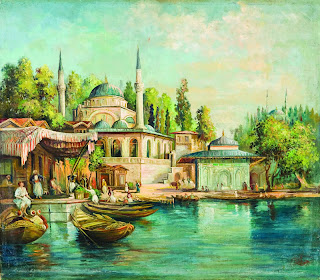How to (correctly) Interpret Ottoman Calligraphy
Ottoman calligraphy is a thorny subject. Just like the era of the artists, we observe the scene is now dominated by religious figures on a scale of absurdity to zealotry. According to these, the artists had one and only one thing in their minds: to promote the prophet; they were overflowing with love of god, so they had to write the same words time after time.
I am not an artist, but I happen to know a few, and I am not obsessed with religion. So I hold a different and radical view on these works of art. As I briefly touched in Hilye-i Serif, the Artist's Battle Cry, they were creative people who had to operate within clearly defined and enforced constraints. Their tools were words that glorified the prophet, their colors the prophet's virtues. If you think they entertained themselves with a sadistic pleasure by inscribing the same words and virtues over and over again, be my guest, or rather their guest who think this way.
On the contrary, they were free spirits who enjoyed life to the fullest. Allow me to explain. Let me introduce the two masters of the art from the 16th century: Ibrahim the Loaded (Sarhos Ibrahim; I do not know his favorite booze or whatever comes to your mind) and Nasuh the Joker (Matrakci Nasuh). OK, you know their names and their nicks. Now, tell me which definition is more likely, theirs or mine. If you still insist, Ibrahim the Loaded for example, had a hangover every morning because he contemplated too much about God at night, I have got nothing else to say.
Or, maybe not. Let us delve into the details of the Joker's life. In addition to being a renowned calligrapher, he was a miniature artist, a geographer, a historian, a mathematician and an expert on weaponry. He wrote three mathematics and geometry books, Cemalu'l-Kuttab, Kemalu'l-Hisab and Umdetu'l-Hisab. The last one had been used as a primary book of reference by mathematicians of the time. His books narrating the campaigns of the Ottoman army were enriched by miniatures he made himself. Last but not least, Suleiman the Magnificent decorated him with a berat for his mastery on weapons; no, not for making them, but for using them. Now, tell me what you see: a man praying every night, or an adventurer!
I am not claiming they were a bunch of atheists disguised as calligraphers. I am simply severing the link between their work and their religious affiliation. How they expressed themselves had no relation to their beliefs. Hence, I want you to look beyond what they wrote and drew. There is a hidden picture, a sublime feeling beneath their work and I want you to discover it.
I am not an artist, but I happen to know a few, and I am not obsessed with religion. So I hold a different and radical view on these works of art. As I briefly touched in Hilye-i Serif, the Artist's Battle Cry, they were creative people who had to operate within clearly defined and enforced constraints. Their tools were words that glorified the prophet, their colors the prophet's virtues. If you think they entertained themselves with a sadistic pleasure by inscribing the same words and virtues over and over again, be my guest, or rather their guest who think this way.
On the contrary, they were free spirits who enjoyed life to the fullest. Allow me to explain. Let me introduce the two masters of the art from the 16th century: Ibrahim the Loaded (Sarhos Ibrahim; I do not know his favorite booze or whatever comes to your mind) and Nasuh the Joker (Matrakci Nasuh). OK, you know their names and their nicks. Now, tell me which definition is more likely, theirs or mine. If you still insist, Ibrahim the Loaded for example, had a hangover every morning because he contemplated too much about God at night, I have got nothing else to say.
Or, maybe not. Let us delve into the details of the Joker's life. In addition to being a renowned calligrapher, he was a miniature artist, a geographer, a historian, a mathematician and an expert on weaponry. He wrote three mathematics and geometry books, Cemalu'l-Kuttab, Kemalu'l-Hisab and Umdetu'l-Hisab. The last one had been used as a primary book of reference by mathematicians of the time. His books narrating the campaigns of the Ottoman army were enriched by miniatures he made himself. Last but not least, Suleiman the Magnificent decorated him with a berat for his mastery on weapons; no, not for making them, but for using them. Now, tell me what you see: a man praying every night, or an adventurer!
I am not claiming they were a bunch of atheists disguised as calligraphers. I am simply severing the link between their work and their religious affiliation. How they expressed themselves had no relation to their beliefs. Hence, I want you to look beyond what they wrote and drew. There is a hidden picture, a sublime feeling beneath their work and I want you to discover it.



Comments
Post a Comment